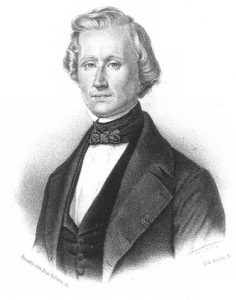
Perihelion is the closest point in a planet’s orbit to the Sun. And Mercury’s happens to behave rather strangely: it moves slightly around the Sun each year and drags the entire orbit with it – something that had not been detected in the orbits of the other planets. It was Urbain Leverrier (1811-1877) – one of Neptune’s discoverers – who drew attention to the phenomenon. Extrapolating from available observations, Leverrier concluded that Mercury’s perihelion and orbit complete a whole turn around the Sun every 227,000 years or so. Leverrier’s theoretical calculations, however, said that it would take 240,000 years. That means an error in the motion of the perihelion of about forty seconds of arc per century; a tiny error, but revealing of a discrepancy between Newton’s theory and the observations that Leverrier wanted to explain. After clearing up the irregularities of Uranus by appealing to the existence of another planet, Neptune, Leverrier supported the idea that Mercury’s discrepancies were due to the existence of a new planet between Mercury and the Sun, or perhaps an asteroid belt. Both hypotheses posed problems, especially that of the new planet: it was highly unlikely that, if it existed, no one would have observed it transiting in front of the Sun.
Leverrier encouraged astronomers to find the trail of either the new planet or the asteroids. And sightings soon followed, although they were mostly the result of suggestion rather than observation. But one such sighting caught Leverrier’s attention. It had been made in 1859 by Edmond Lescarbault, a country doctor and astronomy enthusiast. Leverrier visited him and, after checking Lescarbault’s scientific seriousness, was convinced that he had indeed discovered a new planet, whose orbit he was ready to calculate. It was christened Vulcan, and Leverrier succeeded in getting Napoléon III to award the amateur astronomer the Légion d’Honneur in 1860.
But the years went by and Vulcan has remained a ghost planet, a shadow that someone wanted to see, and saw, where there was nothing. In fact, when in 1907 Einstein began his journey towards general relativity, the problem of Mercury’s perihelion was still a mystery. A mystery that, as Einstein admitted to a friend at Christmas 1907: “I hope to be able to explain with my relativistic version of gravitation which I have just begun to construct”.
So explaining the irregularities of Mercury’s perihelion was one of the demands that Einstein placed on his theory: applied to the Sun and Mercury, his equations had to account for the irregularities observed at Mercury’s perihelion.

After eight years of intense struggle, Einstein succeeded in giving final form to his equations of general relativity during a series of lectures he gave at the Berlin Academy of Sciences in November 1915 – in which he presented several flawed versions of his theory, until the final one on 25 November. In the end, Einstein achieved a success he had been seeking since 1907: to explain the anomalous motion of Mercury’s perihelion – calculations based on earlier versions led to results that were too small to explain the anomalous motion, 18 arcseconds, when the actual anomaly is 45 arcseconds.
Einstein was thrilled when he found that his theory explained Mercury’s perihelion anomaly: “I was three days out of my mind boiling with joyous excitement”; thrilled enough to be ashamed of his earlier sarcasm about the accuracy of astronomical measurements: “The results of the motion of Mercury’s perihelion fill me with great satisfaction. How useful to us is the pedantic accuracy of astronomy, which I used secretly to laugh at”. According to Abraham Pais, one of Einstein’s biographers, his success with Mercury’s perihelion was “by far the strongest emotional experience in Einstein’s scientific life, and perhaps in his entire life. Nature had spoken to him, and he had to be right. “For a few days, I was filled with joy”. Afterwards he told a friend that his discovery had given him palpitations. And even more deep is what he told another friend: when he saw that his calculations coincided with the astronomical observations that had to be explained, it seemed to him that something had really snapped inside him…”.
References
- A.J. Durán, El universo sobre nosotros, Crítica, Barcelona, 2015.

Muy bueno, me gustaría que expliquen el el texto cual es la razón de la irregularidad. Gracias por informar!